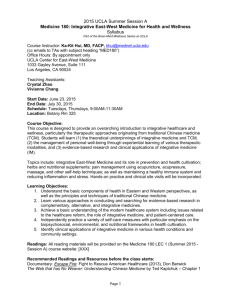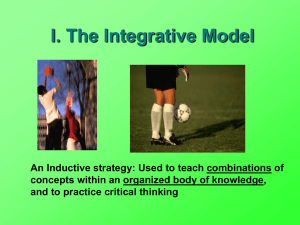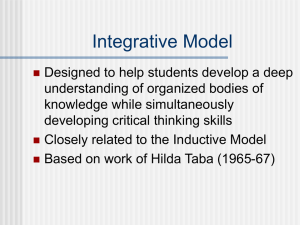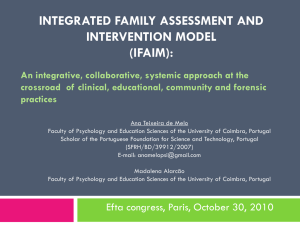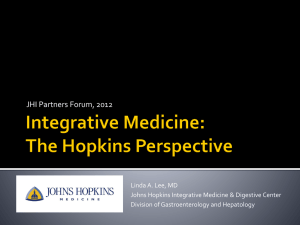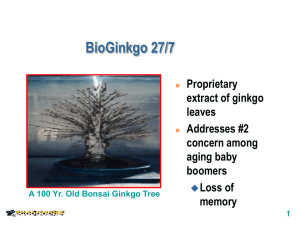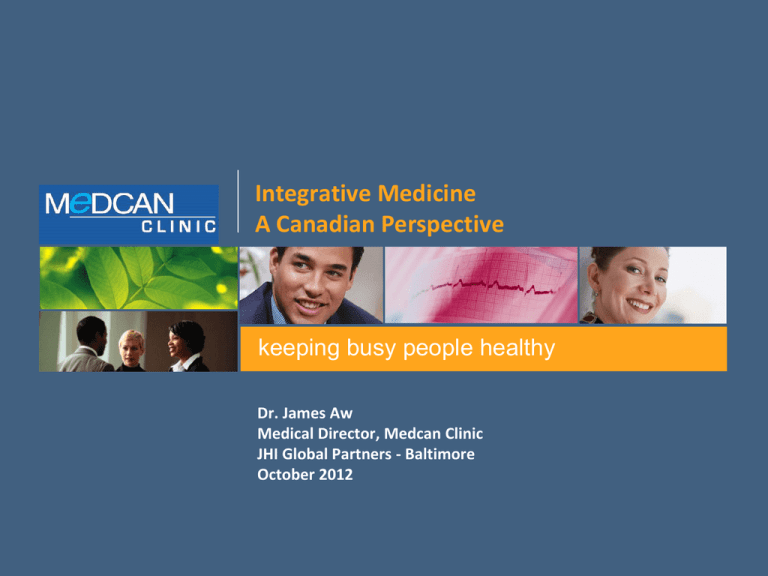
Integrative Medicine
A Canadian Perspective
keeping busy people healthy
Dr. James Aw
Medical Director, Medcan Clinic
JHI Global Partners - Baltimore
October 2012
Making sense of Natural medicine…?
DETOX
diets
Herbal
medicine
Acupuncture
Feng
Shui
Yoga
Crystal
healing
Hydrotherapy
Craniosacral
therapy
What
can I
trust?
Rolfing
Hypnosis
Chelation
therapy
Ion foot
cleanse
2
Nutraceuticals
MindBody
medicine
3
My “Transformational” Experience…
• 1992 - Primary Care Practice in the Toronto Financial District
• 1998 – Tropical Medicine Expedition to Uganda; Travel Medicine Training
• 2000 – Joined Medcan Clinic – Focus on the Individual and Preventive Medicine; 2004 – Medical Director
• 2002 - Husky Injection Molding Systems, Medical Director, Occupational Medicine – Wellness Centre –
Multidisciplinary Practice; Canadian College of Naturopathic Medicine Rounds
• 2004 - Memorial Sloan Kettering Cancer Centre, New York – Integrative Medicine, Dr. Barb Cassileth
• 2009 - Personalized Medicine – Clinical Applications of Genomics (MD partnership with Navigenics)
• 2009-2010 – Physical Therapy / Sports Medicine (Medcan hires first Chiropractor – Acupuncture, Massage,
Physiotherapy, Yoga Back Therapy)
• 2010 - Mind Body Medicine Course for Physicians – Jon Kabat Zinn; 2012 – Yoga classes for staff
• 2010 – Visit To Buddhist Temple - Korea
• 2011- Medcan Mindfulness Cognitive Based Therapy Program – Dr. Patricia Rockman
• 2011 - Hopkins Integrative Medicine – Dr. Linda Lee agrees to clinical observership for Naturopathic Doctor
Ben Klinck (Medcan Staff)
• 2012 – Medcan Integrative Medicine Program
4
•
5
6
7
Why offer Integrative Medicine?
Canadians are increasingly using CAM in conjunction with, not instead of conventional care.
• 12% of Canadians used some sort of CAM service within 12 months, Users tend to be female, high income
and education, middle aged (Metcalfe et al. Univ of Calgary, BMC Comp and Alt Medi 2010)
• 16% of children presenting to a Canadian emergency room were taking natural health products with
potential drug interactions (Goldman et al. Univ of BC, J Ped 2008)
• Canadians with arthritis/rheumatism, asthma, back problems, lung disease, Crohn’s, migraine more likely
CAM users (Stat Canada Nat Pop Health Survey 1994-1999)
Patients seek CAMA when they feel they are missing something from the conventional system.
• 40% used CAM because they had problem communicating with their MD, 2/3 felt that conventional
medicine was not as effective, patients wanted to be more active, holistic (Sirois FM, BMC 2008)
Patients don’t often disclose the use of CAM to their physicians.
• Canadian College of Naturopathic Medicine found that only 58.5% of patients discussed CAM use with their
MD and 70% of MDs do not ask their patients about the use of CAM services. (Busse et al. Mayo Clin Proc
2005).
Metcalfe A et al. Use of comp and alt med by those with a chronic disease and the general population. BMC Comp and Alt Medi 2010
Goldman RD et al. Potential interactions of drug–natural health products and natural health products among children. J Pediatr 2008
Sirois FM. Motivations for consulting compl and alt medicine practitioners: a comparison of consumers from 1997-8 and 2005. BMC Comp Alt Med 2008
Busse JW et al. Disclosure of natural product use to primary care physicians: a cross-sectional survey of naturopathic clinic attendees. Mayo Clin Proc 2005
8
Patient Characteristics
User Characteristics
• Holistic philosophy – Patients believe in mind, body, spirit as important for health
• Transformational Experience – change of worldview – “culturally creative”
• Poorer health status than non-users
• Educated – well read and may question authority
• Less than 5% are solely reliant on alternative health care (want exclusive control,
dissatisfied with healthcare)
Motivation and Expectation
1. Prevention and Well being
2. Influence on natural history of conditions
3. Fewer Side Effects
4. Being in Control
5. Symptom Relief
6. Boost Immune system
Note: Individual variability (i.e. type of disease, severity, type of CAM, Conditioned learning
theory – previous experience)
9
Ernst E et al. Great Expectations -What Do Patients Using Complementary and Alternative Medicine Hope For? Patient 2011.
Commonly Treated Health Issues
• Allergies
• Anxiety
• Asthma
• Cancer
• Colds/flu
• Cardiovascular disease
• Depression/mental health
• Diabetes
• Digestive Disorders
• Environmental medicine
10
• Fibromyalgia/CFS
• Fertility & pregnancy
• Headaches
• Metabolic syndrome
• Pediatrics
• Skin conditions
• Sleeping Disorders
• Women’s/Men’s Health
http://www.ccnm.edu/health_concerns_treated_rsnc
Overview of Medcan Clinic
• Medcan Clinic founded in 1987 by Dr. Robert Francis.
• Outpatient Preventive, Diagnostic and Wellness Clinic occupying 60,000 sq ft in the heart of
Toronto’s financial district staffed by a growing team of 65 doctors and 300 staff. On site
endoscopy, laboratory, fitness studio and multiple specialty clinics. Majority of specialists with
cross appointments at academic hospitals.
• Client base of 30,000 clients, 700 companies and North America’s largest single site executive
health care facility conducting over 15,000 annual health assessments.
• Focus is Excellence in Patient Centred Care, Client Service and Innovation.
• Client Demographics - 70% male, middle aged, higher socioeconomic status, 60% corporately
funded. Growing Demographic – Female, Families, Private Individuals.
• Current research projects focused on clinical applications of genomics, preventive cardiology,
corporate health and developing a longitudinal data base of aging.
11
Medcan Integrative Medicine - Team
• 3 Naturopathic Doctors – Dr. Klinck (interned at Hopkins), Dr. Gowan (Professor at Canadian
Naturopathic College), Dr. Wilkinson
• 2 Chiropractors – Acupuncture, Soft Tissue Management
• Mind Body Medicine – Dr. Rockman (Mindfulness Based Cognitive Therapy)
• Fitness – 36 personal trainers, 10,000 sq ft studio
• Nutrition – 7 Registered Dieticians
• 2 Psychologists – Dr. Hood, Dr. DiGiulio
• 1 Psychiatrist – Dr. Lofchy (University of Toronto)
• Massage Therapist
• Physiotherapy
• Yoga Therapy
• Hopkins Medical Advisory Role – Dr. Linda Lee
• Primary Care Physicians and Specialists (multidisciplinary)
• Programs (Weight Management – Behavioural Change)
• Genetic Counsellors
12
Integrative Medicine - Principles
Integrative Medicine is the combination of mainstream medicine (Conventional) with
Complimentary Alternative Medicine (CAM) that have “high quality scientific evidence of safety
and effectiveness.”
1. “Healing” – body is innately self-healing, power of nature
2. “Patient Centred Care” – holistic approach, doctor patient therapeutic relationship,
communication, “transformational” component – mind, body, spirit
3. “Wellness” - Lifestyle Component – nutrition, physical activity, stress, sleep, spiritual,
occupational functioning, prevention and wellness approach, positive behavioural change
National Institute of Health ( 5 classification )
1. Alternative Medicine – Chinese Medicine (acupuncture), Naturopathic Medicine, Ayurvedic,
homeopathy
2. Biologic Based Therapies – herbal, special dietary, individual biologics not FDA approved
3. Energy Therapies – Reiki, therapeutic touch, magnet therapy, Qi Gong, intercessory prayer
4. Manipulative and Body Based Systems – chiropractic, osteopathy, massage
5. Mind-Body Interventions – meditation, biofeedback, hypnotherapy, relaxation response
13
Medcan Integrative Medicine Service
• The scope of Naturopathic Medicine includes a number of natural modalities. Those used at
Medcan are:
• Herbal medicine
• Nutrition & nutraceuticals
• Acupuncture and Traditional Chinese Medicine (TCM)
• Mind-body medicine
• Lifestyle & general counseling
• Those not used at Medcan currently:
• Hydrotherapy
• Homeopathy
• Medcan Integrative Medicine will be defined as much for what is DOES NOT provide by what it
does.
• Adjunctive therapy (complementary) to conventional medicine (not a replacement).
• Help control symptoms and develop physical and emotional strength.
• Therapies are non-invasive and non-toxic.
• Safe and effective.
14
Review of the Evidence – “Non Specific Effects / Placebo”
• Several reviews of non pharmacological interventions for chronic pain including cognitive behavioural
therapy (CBT), exercise, acupuncture, spinal manipulation, diet, herbal supplements, massage. Clinical
effectiveness strongest for exercise, CBT and mixed for acupuncture.
Non Specific Effects
1. Hawthorne Effect (patients response to observation and assessment)
2. Healing Effect (response to patient-physician interaction)
3. Placebo Effect (response to administration of a “dummy” treatment)
• Placebo effect – 30% of patients respond to placebo for pain (Beecher JAMA 1955); Since then several
studies have found between 27-56% respond to placebo .
• Verbal Suggestions (by the health practitioner) and Prevention Trials trigger larger placebo responses.
• Variability of placebo responses may be dependent on cognitive factors and previous pain experiences.
• Publication of clinical trials is strongly biased in favour of interventions that outperform unspecific
treatment effects. Future approach on “Whole System Research” (WSR) – focus on practitioner-patient
relationship and therapeutic environment; pragmatic trials for assessments of individualized treatments
15
Staud R. Effectiveness of CAM Therapy. Understanding the Evidence. Rheum Dis Clin N Am 2011.
Beecher HK. The powerful placebo. JAMA 1955.
Walach H et al. The therapeutic effect of clinical trials: understanding placebo response rates in clinical trials BMC Med Res Metho 2005.
Memorial Sloan Kettering Integrative Medicine Database
• http://www.mskcc.org/cancer-care/integrative-medicine/about-herbs-botanicals-other-products
• More than 260 entries about dietary supplements, questionable methods, etc. It details constituents,
mechanisms of action, warnings/adverse reactions, drug interactions, etc.
• Bottom Line: Ginkgo does not improve memory or cognitive functioning in healthy people. It was also
found ineffective in decreasing the occurence of dementia or Alzheimer's disease in elderly individuals.
• Scientists have found that in animals and humans, ginkgo dilates blood vessels in the brain thereby, increasing blood flow to the brain. This enables the
body to handle ischemic (low oxygen) conditions, which can help prevent tissue damage. In animal studies, ginkgo showed a beneficial effect on the
tone of the smooth muscle found in arteries, maintaining their appropriate dilation and constriction. Experiments have also revealed that ginkgo can
reduce inflammation and calm muscle spasms. As an antioxidant, it can also neutralize free radicals in the body, which cause cellular and DNA damage.
Laboratory and animal experiments suggest that ginkgo can help prevent infections. Ginkgo also inhibits platelet-activating factor, which is important for
blood clotting, and therefore has blood thinning qualities. Ginkgo supplementation may increase risk of stroke.
16
17
Medcan Integrative Medicine – Early Days
• April to August 2012: Total patients = 192
• 60% female, 40% male
• Offered an introductory consult during their annual health assessment – 30% request a follow up with ND
Prescribed Therapies:
• Dietary – 99%
• Mind Body Medicine – 66%
• Nutraceutical (vitamin, mineral, supplement) – 65%
• Botanical medicine (tea, tincture, encapsulated herb) – 54%
• Acupuncture – 5%
Top Medical Conditions
• Gastrointestinal (IBS, GERD, Food intolerance)
• Osteoarthritis / Joint health
• Insomnia
• Elevated Cholesterol
• Hypertension
• Menopause
• Chronic Fatigue
• Mental Health (anxiety, depression)
• Respiratory (asthma)
• Endocrine (thyroid, Type 2 DM)
18
Lessons Learned
• Strategic Rollout with Physicians – Position statement on Medcan “Scope of Practice”, Workshops, CME
events, Case Rounds, Medical Articles, Advisory Role with Johns Hopkins
• Led by Naturopathic Doctors (regulated health professional, 4 years of training). Mix of academic, clinical
ND (10 yr plus of experience) and ND familiar with Medcan (developed within the organization)
• MDs have been supportive when collaboration required. Initially was concerned about requiring a MD
“specialist” / champion.
• Relationship building between ND and MD team is critical. “One on one” discussions. Consults on shared
care.
• 15 minute “free” consult with a naturopathic doctor. “What is Integrative Medicine?” Customize services.
• Relationship with Pharmacy Online Store to provide natural health products. Simplifies process and
maintains a high level of client service.
• Marketing – Increased awareness amongst corporate clients. Newsletters, seminars, workshops to lay
people. Website presence. Online video and FAQ.
• MDs are still trying to learn how to best co-manage care. Ongoing process.
19
The Doctor – Sir Luke Fildes (1887)
20
Doctor Patient Relationship
• Determinants of the relationship (1) Longitudinal Care – same doctor; (2) Consultation
Experiences – patient encounters; (3) Patient-Doctor Depth of Relationship
• Determinants of Patient’s Perspective of the depth of the MD- Patient relationship include
four elements – KNOWLEDGE, TRUST, LOYALTY and REGARD
• Evidence on impact of patient satisfaction on patient outcomes is mixed.
Three different frameworks to evaluate with respect to Doctor Patient Relationship:
1. Communication Style (report on behavior of the health care provider – verbal and nonverbal communication techniques)
2. Satisfaction Questionnaires (report fulfillment of one’s wishes, expectations or needs, thus
making a judgement on past actions).
3. Relationship Questionnaires (assess emotions or sentiments elicited by contact between
health care provider and patient)
Ridd MJ et al. Patient-Doctor Depth-of-Relationship Scale: Development and Validation. Annals Fam Med. 2011
Van der Weijedn T et al. Clinical practice guidelines and patient decision aids. An inevitable relationship. J of Clin Epid 2012 .
21
Patient Doctor Depth of Relationship Scale
Ridd MJ et al. Patient-Doctor Depth-of-Relationship Scale: Development and Validation. Annals Fam Med. 2011
22
Primary care: is there enough time for prevention?
• Am J Public Health. 2003 Apr;93(4):635-41.
• Primary care: is there enough time for prevention?
• Yarnall KS, Pollak KI, Østbye T, Krause KM, Michener JL.
• Department of Community and Family Medicine, Duke University Medical Center, Durham, NC
27710, USA. yarna001@mc.duke.edu
• OBJECTIVES: We sought to determine the amount of time required for a primary care physician
to provide recommended preventive services to an average patient panel. METHODS: We used
published and estimated times per service to determine the physician time required to provide
all services recommended by the US Preventive Services Task Force (USPSTF), at the
recommended frequency, to a patient panel of 2500 with an age and sex distribution similar to
that of the US population. RESULTS: To fully satisfy the USPSTF recommendations, 1773 hours
of a physician's annual time, or 7.4 hours per working day, is needed for the provision of
preventive services. CONCLUSIONS: Time constraints limit the ability of physicians to comply
with preventive services recommendations.
23
Depth of Relationship – Well being / Life Satisfaction
MD Patient Relationship
• Patient Doctor Relationship Questionnaires (9 question – PDRQ; 5 point scale Ridd)
• Bakers’ Consultation Satisfaction Questionnaire (CSQ)
• Perception of Continuity Scale (PC)
Well Being – Positive Psychology
• Life Satisfaction Questionnaire: www.ppc.sas.upenn.edu/lifesatisfactionscale.pdf
• Positive and Negative Affect Scales (PANAS – 20 item 5 point scales)
• Validated Outcome Tools (rehab medicine) – www.parqol.com/page.cfm?id=60
24
25


